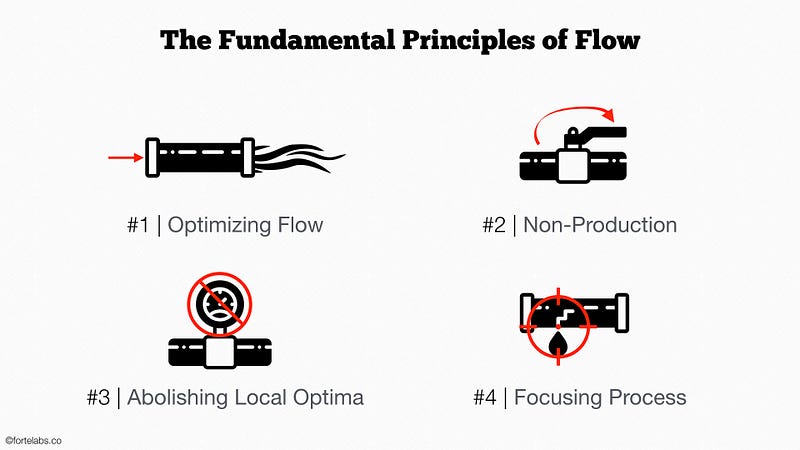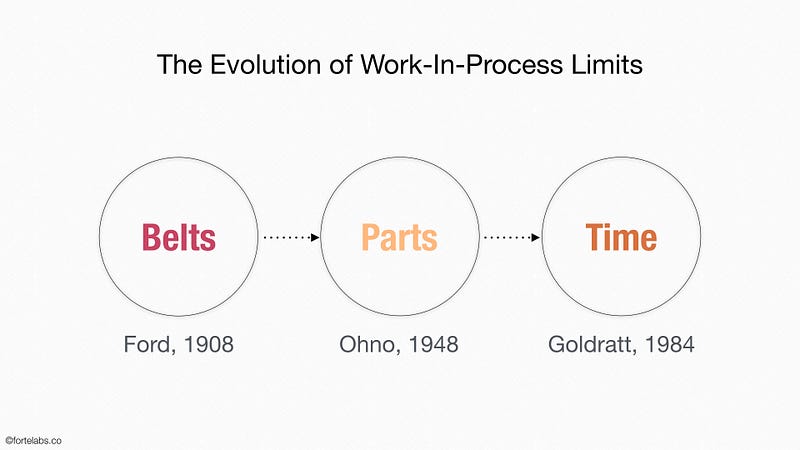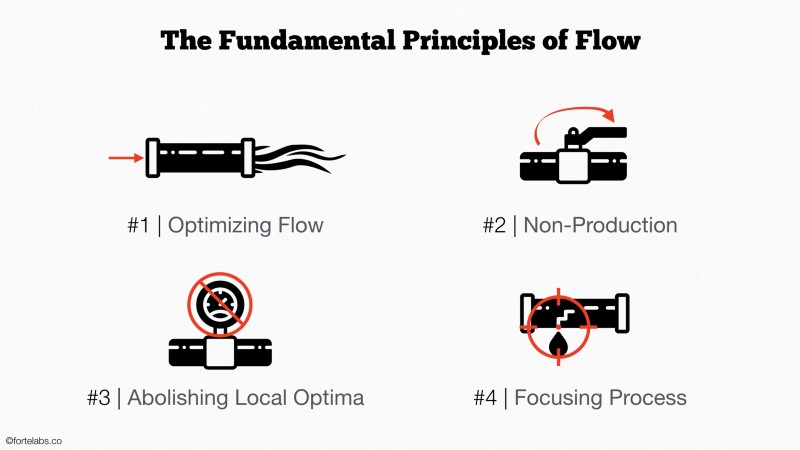In the previous post, I described how many companies’ embrace of local optima leads to overwork and burnout for employees, and reduced throughput and profitability for the bottom line.
Before we look at what TOC proposes as a solution, we have to take a brief look at the history of flow, beginning with Henry Ford.
Ford is remembered today mostly for Model Ts and pithy quotes, but his real contribution was the discovery of the Four Fundamental Principles of Flow:
- Optimizing flow: The primary objective of operations is to improve flow (also known as throughput, defined as revenue minus marginal costs)
- Non-production: The key to improving flow is establishing a practical mechanism to determine when not to produce
- Abolishing local optima: Local efficiencies (better known today as “local optima”) must be abolished
- Focusing process: Improvement must be guided using a focusing process, directed to where it will make the biggest difference at any given time

As Ford’s production and assembly lines swept the world, consuming industry after industry with its unprecedented performance, it was assumed that only very large quantities of identical products could justify the dedication of an entire line. Assumed by everyone, that is, except a Japanese engineer named Taichii Ohno.
What Ohno realized was that the principles of flow were generic. The genius of Ford’s system was not just its speed and uniformity, but the novel way it was able to limit work-in-process inventory, the great enemy of flow. By connecting the work centers with a conveyor belt and strictly limiting the amount of space between them, work-in-process was simply not allowed to pile up. Upstream resources literally could not produce faster than downstream resources, since any problem in the inter-connected line would cause the whole thing to grind to a halt.
Ohno faced a very different situation: the Japanese market demanded small quantities of a variety of cars. He couldn’t afford to dedicate equipment to one big run of a single model, since each machine had to work on a mix of different parts. And that was where most small manufacturers stopped their investigations — “It can’t be done!”
But Ohno realized he could limit work-in-process through a different means — directly limiting the number of parts allowed to accumulate between work centers. Based on this realization he designed the Kanban system. Each container full of parts would be accompanied by a small card (“kanban” in Japanese) that specified how many parts belonged in the container. As the container was moved forward, the card would be sent backward, signaling the previous operation to produce exactly that many parts once again, and no more. The power of Kanban was in telling each worker when not to produce. Ohno had successfully translated Ford’s Principle #2 of Non-Production to his own context by changing the constraining mechanism from belts to parts.
Ohno had another challenge: how to focus the process of continuous improvement (Principle #4). Ohno’s difficulty was that not having dedicated equipment made it almost impossible to find the problems that jeopardize flow just by looking. His solution was the “rocks and water” analogy. Gradually reducing the batch size was like slowly lowering the water level. As long as flow was not interrupted, the operating parameters continued to be slowly tightened. Eventually, this “falling water level” would reveal “rocks” (obstacles to flow) lurking below. When one was revealed, special techniques were used to pinpoint, identify, and permanently fix the root cause of the disturbance. These techniques evolved into the Lean Movement (originally known as “Toyotism”).
The gains in productivity unleashed by this system, simply put, gave birth to the modern world. From cars to soap to TVs to pharmaceuticals to the precisely manufactured device you’re using at this very moment.
But the Toyota Production System (known more broadly as Just-In-Time manufacturing) wasn’t perfect. It was just one application of more fundamental principles, suited to a particular time and place. Even as it was being developed, its flaws started to become apparent.
The biggest problem was that TPS/Lean demanded stability and predictability in both the internal (production) environment and external (market) environment. Internally, every factor that could affect variability had to be tightly controlled to multiple decimal places. This explains the dirty secret of Lean: it takes incredibly long to implement. Nine months per production line is the (rather optimistic) recommendation of the Toyota Supplier Support Center. In reality, as long as 10 years was sometimes required to implement the system across a company.
In the external environment the demand for predictability was, of course, even more problematic. Despite Toyota’s relatively stable flow of orders, it had to establish a mode of receiving orders (and promising deliveries) that restricted the mix change from one month to the next. Most companies are not able to enforce such favorable terms on their suppliers and customers. And worst of all, this source of instability was not something within the power of production to control. It came from the way products were marketed and sold, not produced.
This is the situation into which Eliyahu Goldratt stepped in 1984, with the publication of The Goal. A physicist by training, Goldratt in many ways played the same role as Ohno decades earlier, translating the fundamental principles of flow to a new paradigm.
What Goldratt realized was that a more effective mechanism for limiting work-in-process was not physical limits (belts and parts), but time. He proposed restricting work-in-process not by fussing about with lines and containers and parts, but by more directly limiting the overall amount of work at all stages of the system. His method used three time-based leverage points: the processing rate of the bottleneck, strategically placed buffers, and the timing of “release of materials.” These correspond to the three main parts of the manufacturing production system Goldratt designed: Drum-Buffer-Rope.

Using the mechanism of time allowed the principles of flow to be applied far beyond the world of manufacturing — to project-based environments, to sales and marketing, to retail and services, and eventually, to software development.
In all these creative fields, work moves not through the sequential, linear flow of an assembly line, but the even more rigid, even more linear flow of time.
That insight is the key to understanding how these ideas, born in the greasy world of factory manufacturing, are just as relevant for the knowledge work of today.




